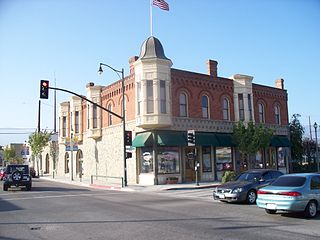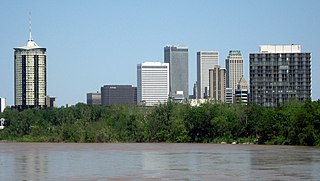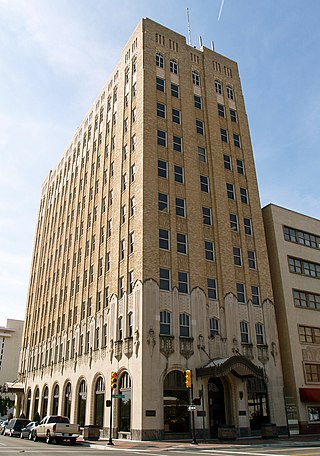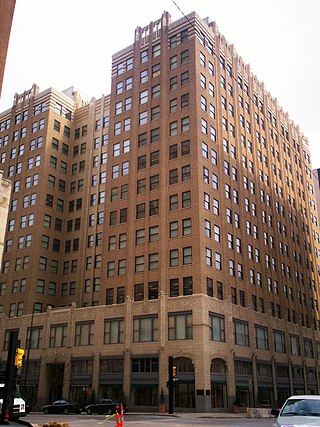
The National Register of Historic Places (NRHP) is the United States federal government's official list of sites, buildings, structures, districts, and objects deemed worthy of preservation for their historical significance or "great artistic value".

Tulsa County is a county located in the U.S. state of Oklahoma. As of the 2020 census, the population was 669,279, making it the second-most populous county in the state, behind only Oklahoma County. Its county seat and largest city is Tulsa, the second-largest city in the state. Founded at statehood, in 1907, it was named after the previously established city of Tulsa. Before statehood, the area was part of both the Creek Nation and the Cooweescoowee District of Cherokee Nation in Indian Territory. Tulsa County is included in the Tulsa metropolitan statistical area. Tulsa County is notable for being the most densely populated county in the state. Tulsa County also ranks as having the highest income.

Okmulgee is a city in and the county seat of Okmulgee County, Oklahoma, United States, and is part of the Tulsa Metropolitan Area. The name is from the Muskogee word okimulgi, which means "boiling waters". The site was chosen because of the nearby rivers and springs. Okmulgee is 38 miles south of Tulsa and 13 miles north of Henryetta via US-75.

Bartlesville is a city mostly in Washington County and Osage County, Oklahoma. The population was 37,290 at the 2020 census. Bartlesville is 47 miles (76 km) north of Tulsa and 18 miles (29 km) south of the Kansas border. It is the county seat of Washington County. The Caney River runs through Bartlesville.

The Santa Paula Hardware Company Building, located in Santa Paula, California, and more commonly referred to as the Union Oil Company Building, is significant for its historical importance as the birthplace of the Union Oil Company on October 17, 1890. Originally, the Santa Paula Hardware and Post Office were downstairs, and the Union Oil Company offices were upstairs. The building continued to serve as a field division office after the main headquarters moved to Los Angeles in 1900.
The title of "Oil Capital of the World" is often used to refer to Tulsa, Oklahoma. Houston, Texas, the current center of the oil industry, more frequently uses the sobriquet “The Energy Capital of the World.”

List of the National Register of Historic Places listings in Franklin County, New York

The Mid-Continent Tower is a 36-story skyscraper located at 401 South Boston Avenue in downtown Tulsa, Oklahoma. At 156 meters (513 ft) in height, it is the fourth-tallest building in Tulsa and fifth-tallest in Oklahoma. Faced with bright white terra cotta and crowned with a distinctive copper roof, it is one of the city's most recognizable buildings. The design is unique because the first 16-story structure was built in 1918. The top 20 stories comprise a separate structure, cantilevered over the first 66 years later. The architects of the addition matched the design of the original structure so carefully that the result is considered a single structure. It is included as a contributing structure in Tulsa's Oil Capital Historic District.

The Philtower Building is a historic building located at 427 South Boston Avenue in Tulsa, Oklahoma.

Tulsa is the second-largest city in the state of Oklahoma. It has many diverse neighborhoods due to its size.

Will Rogers Middle and High School, located at 3909 E. 5th Place in Tulsa, Oklahoma, was built by Tulsa Public Schools in 1939 using WPA workers and designed by Joseph R. Koberling, Jr. and Leon B. Senter. It was named for the humorist Will Rogers, who died in 1935, along with Wiley Post in a plane crash. Significant additions were made to the original structure in 1949 and 1964. The alterations were in keeping with the original design and did not detract from the school's architectural or historical significance. It has been called "... one of the best examples of Art Deco high school architecture...in the United States.
Gillette Historic District (GHD) is a residential area in the Midtown section of Tulsa, Oklahoma. It consists of the homes on Gillette Avenue and Yorktown Place, and is bounded by 15th Street on the north, the alley between Gillette Street and Lewis Avenue on the east, 17th Street on the south and the alley between Yorktown Place and Yorktown Avenue. It contains 31 single-family homes and 6 duplexes that were constructed between 1924 and 1941. The district were named for James Max Gillette, a merchant, real estate entrepreneur and oilman who built his home in what is now the district in 1921.

The Oklahoma Natural Gas Company Building is a historic building in Tulsa, Oklahoma, at 624 South Boston Ave. It was one of the first local Art Deco buildings built in the new Art Deco style, along with the Public Service of Oklahoma Building. This choice by the relatively conservative utility companies made the style acceptable in the city, with many Art Deco buildings built subsequently in Tulsa. The building was designed by Frank V. Kirshner and Arthur M. Atkinson. It was built of reinforced concrete, and clad in buff brick, except for the lower two stories, which are clad in limestone. The verticalness of the building is emphasized by piers rising the entire height of the facade with windows placed between the piers.

The United States Post Office and Court House in Tulsa, Oklahoma, also known as Federal Building, is a federal building of the United States government completed in 1917 and located at 224 South Boulder Avenue. The supervising architect for both the original construction and a substantial extension completed in 1933 was James A. Wetmore. The building houses a post office and housed the United States District Court for the Eastern District of Oklahoma from 1917 to 1925, when the districts were reconfigured and it became a courthouse of the Northern District of Oklahoma.

The 11th Street Bridge was completed in December 1915 to carry vehicles across the Arkansas River at Tulsa, Oklahoma. Used from 1916 to 1972, it was also a part of U.S. Route 66. Functionally, it has been replaced by the I-244 bridges across the Arkansas. As of 2009, the bridge was in poor structural condition and unsafe even for pedestrians. In 2008, the gates were locked to exclude all visitors.

The Mayo Building at the northwest corner of West Fifth Street and South Main St. in Tulsa, Oklahoma was built in 1910. It had five stories. It was expanded by a duplicate building to the north in 1914, and further expanded by addition of 5 more stories in 1917. It was listed on the National Register of Historic Places (NRHP) in 2008.
The following is a timeline of the history of the city of Tulsa, Oklahoma, United States.

The Philcade Building is an office building in downtown Tulsa, Oklahoma at the southeast corner of East 5th Street and South Boston Avenue. Designed by Leon B. Senter, for oilman Waite Phillips, it was begun in 1929 and completed in 1931. It is noted for its Art Deco zigzag style architecture. The building was listed in the National Register on September 18, 1986, under National Register Criterion C. Its NRIS number is 86002196. It is also a contributing property of the Oil Capital Historic District in Tulsa.

The Oil Capital Historic District (OCHD) is an area in downtown Tulsa, Oklahoma that commemorates the success of the oil business in Tulsa during the early 20th century. During this period, Tulsa was widely known as "The Oil Capital of the World." The area is bounded by 3rd Street on the north and 7th Street on the south, Cincinnati Avenue on the east and Cheyenne Avenue on the west.

General Patrick Hurley opened the Ambassador Hotel in 1929, intending it to be a luxury "extended stay" residence for Tulsa businessmen, who were building mansions that were not yet ready for occupancy. Hurley never stayed in the hotel he founded. He moved to Washington, D. C. in March 1929, after President Herbert Hoover chose him to be Secretary of War, after the death of the previous Secretary, who died in December 1929. Hurley never returned to Tulsa.



















